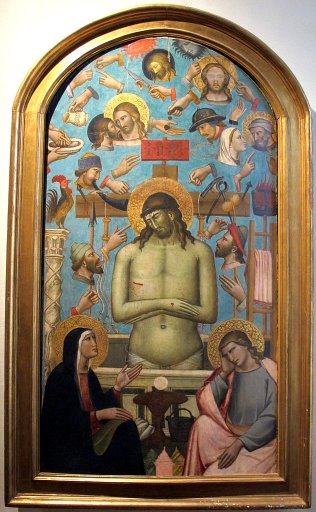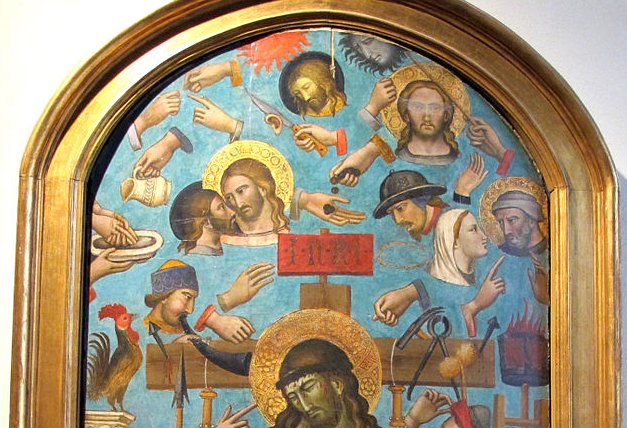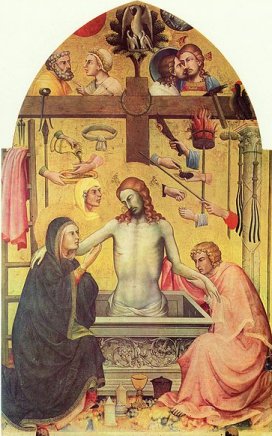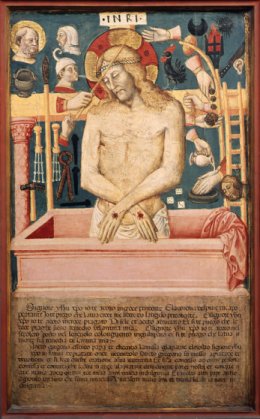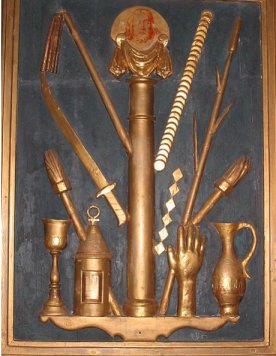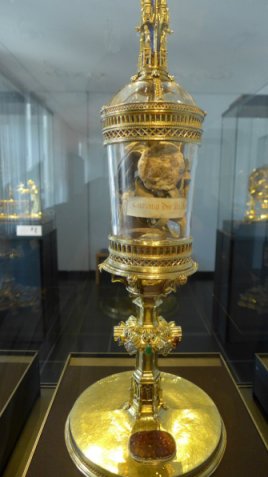|
The Passion of Christ |
|
|
Arma Christi |
|
|
In the Museo Statale d'Arte Medievale e Moderna in Arezzo is this strange, almost surreal painting by Niccolo di Pietro Gerini. |
|
|
|
|
| The strange objects are the Arma Christi, the weapons of Christ, otherwise known as the Instruments of the Passion. Let's see the top half in more detail. | |
|
|
|
|
It's an intriguing puzzle. Some of the
objects are straightforward. There's Peter's knife cutting off that ear,
Judas's bribe and kiss, Pilate washing his hands, the crowing cockerel,
many cruel hands, the nails, the spear and the sponge of the
Crucifixion. It seems a strange picture, but it was a familiar genre in late medieval art. Here are two more examples. |
|
|
|
|
|
So what objects are considered to be 'Instruments of the Passion'? Generally these are things involved in the downfall, ill-treatment and Crucifixion of Christ, but not exclusively: items such as the veil of Veronica may be included too. Here's a list: it may help to work out what is included in the images above! |
|
|
The Cross The crown of Thorns The pillar of the Flagellation The sponge The lance The four nails The reed presented the Christ as a mock sceptre Christís seamless robe The robe in which Jesus was mocked The inscription on the cross The chalice used at the last Supper Dice and money used by the soldiers Judasís bribe The crowing cockerel The ladder used at the deposition |
Vessels for holding the gall and vinegar, and the Myrrh. The Hammer used to drive in the nails, and a pair of pincers used to remove them. Christís shroud. Veronicaís veil Hands which ill-treated Christ, and aggressive heads, sometimes one of them spitting. Heads of others such as Judas and Pilate. Pilate washing his hands. The chains which bound Christ after the arrest The burning torches used at the betrayal Swords of the soldiers The sword or knife used by Peter to cut off the servantís ear; sometimes the ear is included. |
|
Later representations of the Instruments of the Passion took various forms, such as crucifixes draped with various items, and constructions such as this at St. Peter's Church, Collonges-la-Rouge, in France. |
|
|
|
|
|
Relics In the modern world, even the devout may well be sceptical of supposedly genuine relics such as the Turin shroud. However, their importance in the medieval world should not be underestimated, and even if the authenticity of the relics themselves is dubious, the reliquaries and buildings that contain them are often wonderful works of art. It is perhaps the Crown of Thorns that has inspired the finest artistic response - Saint Chapelle in Paris. Ceremonies involving relics continue, such as the Rite of the Nivola in the Duomo in Milan, when the bishop ascends (somewhat precariously) in a cloud to retrieve a crucifixion nail. Never mind that there are more than twenty nails in existence claiming to be genuine; the ritual is both symbolic and meaningful. In March 2015 my wife and I went to Aachen - see my report in the 'not a blog' pages. Aachen is relic central: Jesus's Swaddling clothes, his belt, and his loin cloth from the Crucifixion are just some of them. Here, in the Treasury, is the reliquary containing the flagellation rope. Well, maybe it isn't, but what a beautiful object! |
|
|
|
|
